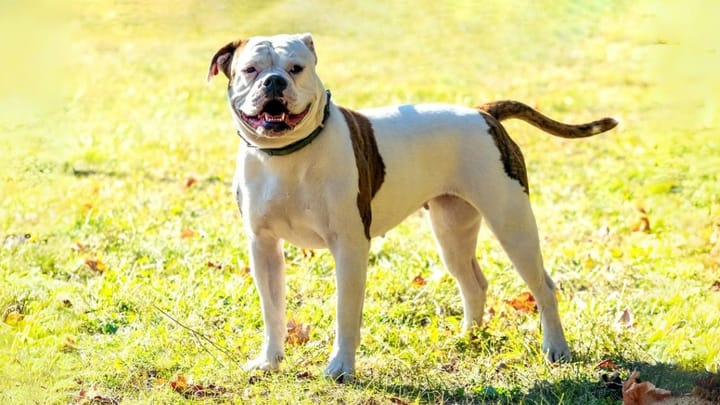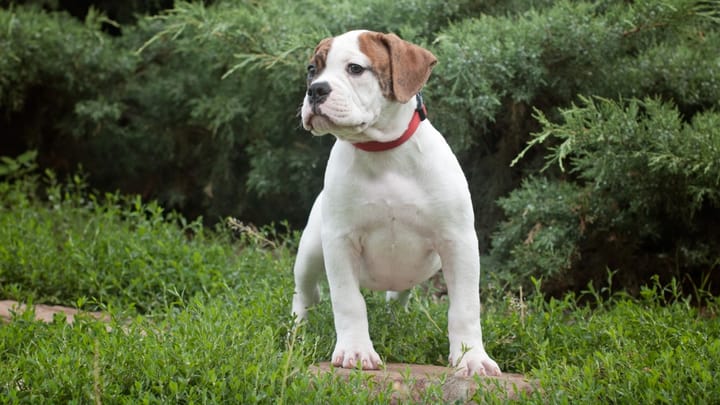American Bulldog
Other name: Ambulldog


The American Bulldog is a dog of molosse type, originating, as the name suggests, from the United States. This dog is not part of any breed group since the FCI has not yet formally integrated this breed into its nomenclature. There are two types, Standard (Scott) and Bully (Classic). Used exclusively as a farm or guard dog at the time, they are now present in many households, including those with children. Affectionate, loyal, faithful, playful and intelligent, this dog adapts very well to family life. Despite appearances, this dog has never been a fighting dog and its categorisation is far from truthful.
|
Life expectancy |
The American Bulldog has a life expectancy of between 11 and 14 years |
|
Temperament |
|
|
Size |
Large
|
|
Adult size |
Female
Between 21 and 24 in
Male
Between 22 and 26 in
|
|
Adult weight |
Female
Between 66 and 99 lb
Male
Between 77 and 121 lb
|
|
Coat colour
The American Bulldog can have a white coat with or without brindle, chestnut, fawn, or red shades. Solid black, blue, merle or tricolour coats are not accepted. |
Black White Brown |
|
Type of coat
The fur is short. Fur can vary between soft and stiff but must never be long, curly or frizzy. |
Short |
|
Eye colour
Preferably black or dark brown, the eyes can be of different colours but brown or blue eyes with a lack of pigment constitute a defect. |
Brown
|
|
Purchase price |
The American Bulldog costs approximately 650£ |
Despite appearances, this Bulldog is not automatically implicated by the Dangerous Dogs Act 1991 about the so-called dangerous dogs, but this still sparks debate. This dog shares the molosser physique and it is problematic that the breed is not recognised.
Indeed, the American Bulldog is not officially recognised by the FCI and therefore nor by the Central Canine Society, it can not be a recognised pedigree according to the KC but can however have a pedigree issued by US institutions.
Moreover, to be part of this category (dogs considered "dangerous"), the dog must closely resemble certain morphotypes like the American staffordshire terrier, Boerboel, Mastiff or Tosa. However, many specialists and experts of the breed defend them by highlighting the clear differences that exist between the American Bulldog and the “dangerous” category dogs.
The Minister of Agriculture response to this question (answer published in the Senate of April 9, 2015): all questions that owners of an American Bulldog want to ask about the potential categorisation of their dog are treated case by case, according to the morphology of the dog.
In fact, owners must use a vet or a judge of the certified dog trainer to decide (determine the characteristics of a species) this will allow the issue of a certificate that confirms (or not depending on the results) whether the dog belongs to the first category of the 1999 law on so-called "dangerous" dogs.
More details about the American Bulldog
American Bulldog: Origins and history
Before the 19th century, there is no sign that this breed existed. The modern American Bulldog is thought to have originated from ancient breeds similar to those of other mastiff breeds. At the time, American Bulldogs were used exclusively for work as a butcher's, farmer's or guard dog. They were absolutely not domesticated but modern selective breeding made it possible to highlight the undeniable qualities of this dog which make it a very good pet too. It was the breeders John D. Johnson and Alan Scott who allowed the development of this breed from the 40's.
There are currently two types of American Bulldogs: standard (pitbull descendant) and bully (descendant of the English bulldog). However, nowadays, it is mainly American hybrid bulldogs that you will see (a cross between the Bully type and Standard type).
The official recognition of the breed in the United States was established in 1970. Unfortunately, the differences between the dogs within the breed complicates the recognition of the breed in other countries as well as at the international level.
Physical characteristics of the American Bulldog
The American Bulldog is medium to large in size, of molosser type. They have a powerful, compact and athletic look. The skeleton and musculature is well developed. The male is stockier, with a heavier frame than the female, which is typically more slender. The head is large and broad, the flat forehead gives the impression of a square skull. The stop is deep and well defined (slightly less for the Standard type). The ears are average in size and preferably drop or rose. Pricked or hound ears are a major fault. The tail is carried at mid-height, thick at the base, it tapers to the point and must be carried upright over the line of the back.
Three types exist: Bully type (classic) which is bigger and used as a guard dog; the Standard type (scott) which is taller, slender and is more often used as a farm dog; and finally the hybrid type, the most common, which is a cross between the two previous types.
American Bulldog: Varieties
- Bully American Bulldog (Classic)
- Standard American Bulldog (Scott)
- Hybrid American Bulldog (Bully x Standard)
American Bulldog: Characteristics
American Bulldog: Behaviour
Training a American Bulldog
Although more docile than their molosser cousins, the American Bulldog remains a bit stubborn and can be difficult to educate, especially by amateur masters.
However, if a relationship of trust and mutual respect between the master and his dog is established and the educational methods respect the principles of positive and non-violent education, it can be very pleasant to interact with an American Bulldog.
One must not in any case seek any balance of power with him, at the risk of fanning his aggression and turn him into a dangerous dog. There are no bad dogs, only bad teachers, so it is important to know how to educate a dog with firmness and gentleness before adopting this breed.
Socialisation will have to be one of the key points of your dog’s education because this breed tends to want to dominate other dogs, sometimes seeking a fight.
American Bulldog: Lifestyle
Breed compatibility American Bulldog
American Bulldog: Purchase price
The price of an American Bulldog varies according to their origins, age and sex. This breed would cost on average £650.
Please note that it can be difficult to get an American Bulldog since the breed is not officially recognised outside the United States.
Regarding the monthly budget, a dog this size will cost about £50 (food and typical annual care included).
American Bulldog: Shedding
Average
This breed’s light coat means they lose very little hair.
American Bulldog: Grooming
Maintaining an American Bulldog is very simple thanks to their short hair. Weekly brushing is enough to maintain the beauty of the coat.
Eyes and ears should be monitored and cleaned regularly to prevent infection.
This dog does not need to be groomed unless very dirty obviously. Frequent baths could harm and remove the protective layer which gives the dog a degree of protection against the cold and parasites.
American Bulldog: Health
Life expectancy is around 13 years.
This is a robust and resistant dog that can nevertheless suffer from respiratory problems, because of its brachycephalic morphology.
The American Bulldog’s squashed nose does not tolerate heat well and means they can suffer from respiratory problems and are unable to quickly adapt their body temperature.
Despite their robustness, it is advisable to let your dog sleep indoors because it may not be able to withstand extreme weather conditions.
Very greedy, an American Bulldog can quickly become obese if they are not fed a balanced diet as well as enjoying regular physical activities.






